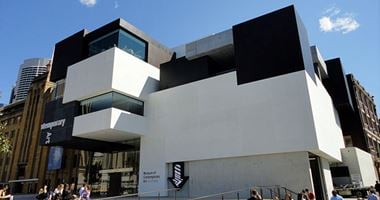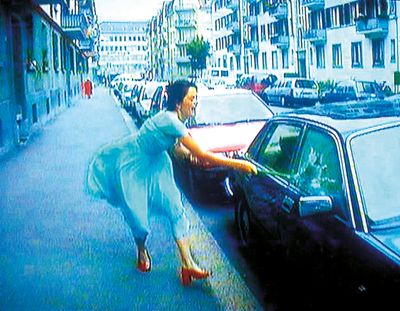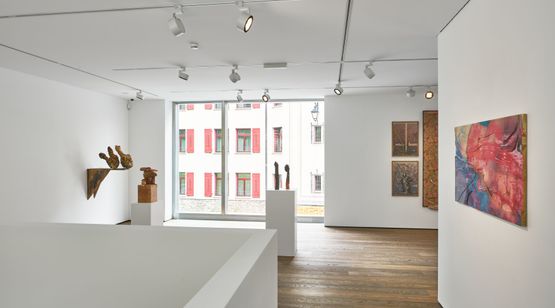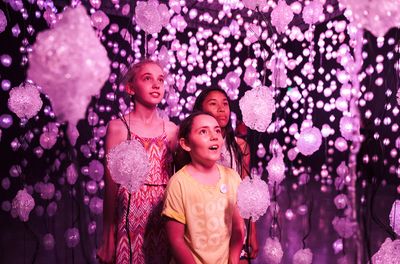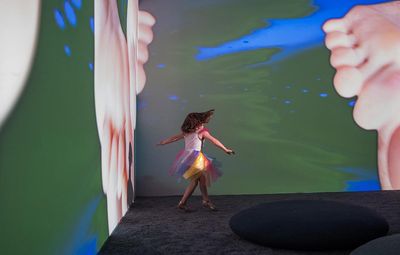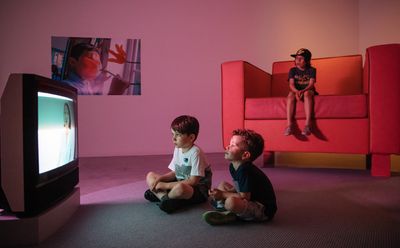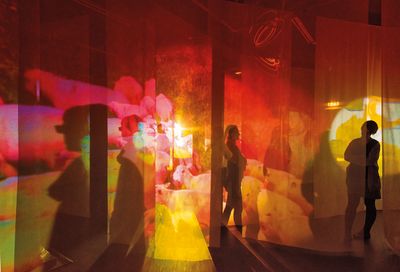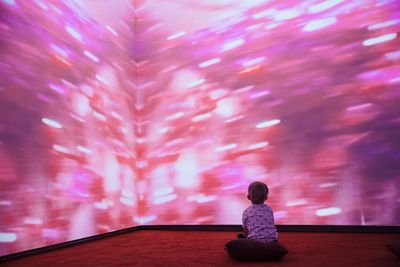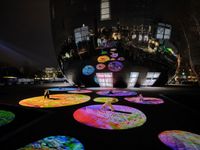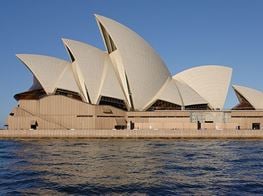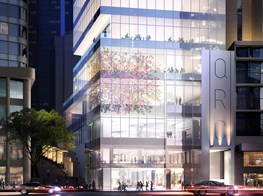Pipilotti Rist
Pipilotti Rist. Photo: Daniel Boud.
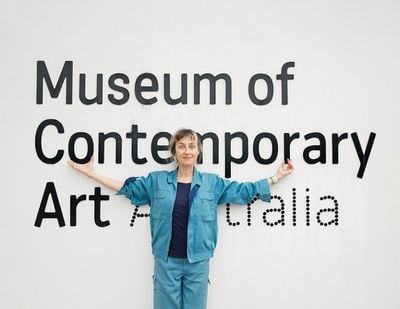
Pipilotti Rist. Photo: Daniel Boud.
Pipilotti Rist configures sensory and colour-saturated universes that transport the viewer into hyper-visual sequences of moving image, film, and objects.
Between 1 November 2017 and 18 February 2018, the Museum of Contemporary Art Australia in Sydney presents Rist's major new exhibition Sip My Ocean (1 November 2017–18 February 2018), expertly curated by Senior Curator Natasha Bullock. Accompanied by a sumptuous catalogue, the exhibition highlighted the spectrum of Rist's practice, from her early single-channel videos to large-scale immersive environments, culminating in Your Room Opposite the Opera (2017): a room with tiny domestic objects and projections assembled in a crate.
One highlight of Sip My Ocean was Rist's seminal video Ever is Over All (1997), in which she walks up a city sidewalk in a blue dress and sparkly red shoes nonchalantly smashing car windows with a red-hot flower poker, rejoicing with glee. Partnered with lush footage of a field of red-hot pokers, Ever is Over All was awarded the Premio 2000 for outstanding achievement by a young artist at the 1997 Venice Biennale.
Born in 1962 in Grabs, a small Swiss village on the edge of the Rhine Valley, Rist is the second of five children, with the given name Elisabeth Charlotte Rist. When she left home at 19, she began introducing herself as Pipilotti: an amalgamation of her childhood nickname 'Lotti' and 'Pippi', after the children's book character Pippi Longstocking, known for her quirky character.
In the early 1980s, Rist studied commercial art, illustration, and photography at the University of Applied Arts in Vienna, and was a member of the music band Les Reines Prochaines from 1988 to 1994.
In 2005, I vividly recall being mesmerised by Rist's Edenic video Homo sapiens sapiens (2005), which was projected on the Baroque cupola of San Stae Church as part of the 51st Venice Biennale.
Lying down to view Rist's paradise, I was offered respite from the glaring and unremitting heat of Venice and seduced by comfortable lounges and sensual imagery: 'exploding into pieces of pleasure'. In this conversation, Rist, who uses hysteria and extreme feelings as a survival tactic, talks about love, music, and the importance of all-encompassing sensory experiences in her works.
Your exhibition Sip My Ocean was rapturous and hallucinatory—a colour-saturated universe drenched in ideas and feelings. Given that we live in times of seismic upheaval and turbulence, what is the role of seduction and euphoria in your work?
I am not sure if I precisely understand what you mean by the word 'seduction' as it holds a corrupt and untrustworthy flavour to me. If you mean the ability to transport a visitor to a calmer moment where one feels connected with others and the unbelievable evolution of the universe, then I can agree with this expression.
In a time with endless electrical humming of refrigerators, air conditioners, and all the other electrical devices around us, my work is a search to bring a poetic, emotional, and philosophical sense of logic back to the electronic; with the knowledge that our brain processes impressions with low voltage signals between synapses. That we react stronger to the negative signs of our times—'seismic upheaval and turbulence', as you phrased it—is a psychological fact, as our brain is evolutionarily wired that way.
We have become more eager and accustomed to ignoring our achievements and positive outcomes. There are many strong works by artists and writers that focus on the negative, which I appreciate greatly, but there are also works that instead peel out overlooked signs and their potential.
NKSome new works manipulate scale in a Lilliputian way, such as the miniature world in Your Room Opposite the Opera (2017), or Cape Cod Chandelier (2011), an adjustable rotary clothing line with underwear draped over it. How do you configure scale?
PRHow we perceive scale is completely relative, not considering that all blood vessels of a human stretched out would go around the world twice. In my work, I am referring to inner human worlds, often most active when you feel safe. For example, the feeling when you are in a bed, or your home as a symbol of civilisation that protects you from the natural extremes of temperature, wind, rain, and snow.
When you are half awake an arm can seem like a continent and a cold hand like a grain of rice. The Cape Cod Chandelier you mention is trying to treat this tension of our most loaded and heavy body part in a way that it becomes a tool of 'light'. The contradictions of shame, love, pain, pleasure, stinking, and transcendence become a lamp under which roundelays can occur. It is reminiscent of the origin from which we excitingly saw the light when we were first born.
NKThere was a distinctive focus on the role of children in your exhibition at MCA, with a dedicated kid's vernissage, children's activities, and a candy coloured pop-up café. Why are children an important consideration in your work?
PRAs adults, we waste so much time and energy analysing our behaviour, even when we just do something for fun. The piece I did with the oversized red living room had visitors sinking back into something they weren't really aware of anymore; sitting in that huge armchair made you remember the time when everything used to be too big and too tall, but it was also a time when you knew: 'it's all mine'. For children, the whole world belongs to them. People acted as if the museum was an extended living room. I like that.
NKCan you elaborate on how some of the works in Sip My Ocean involved viewing in a state of repose—enabled by beds and comfortable cushions—in order to deepen the viewer's experience?
PRIn times when humans think the world is at their fingertips and all their knowledge is caught behind screens, I treat collective rooms—such as museums—as a space to invite visitors' whole bodies; a space where groups of people who don't know each other can spend time in a common surrounding.
To only ask viewers to parade by works displayed horizontally seems to me a missed opportunity, and contemptuous towards the other. Please don't get me wrong, there are great exhibitions like this, but for my practice it makes no sense to ignore the three-dimensional space and limit possible postures to simply standing on two feet, as well as neglecting the possibilities of the ceiling.
I want to create spaces for video art that rethink the very nature of the medium itself. I want to discover new ways of configuring the world, both the world outside and the world within. I like installations that really get you involved, that make you part of them, or that even work like a lullaby.
When I do projections, I want people to move into the surface of projection so that colours, movement, and pictures are reflected on their bodies.
NKThe colour red, emblematic of passion, features as a dominant palette in your work. Can you discuss your choice of colour?
PRColour is dangerous; you fall into it. And colour can swallow you, and like music it is super emotional. It is hard to stay distant.
NKIn the video installation Sip My Ocean, two screens on adjoining walls project kaleidoscopic, dreamlike images, culminating in the repeated lyrics 'I don't want to fall in love', taken from Chris Isaak's 1990 song 'Wicked Game'. What is the role of love in your work?
PRLove signifies the moment when you no longer feel isolated in your own skin, when you can no longer distinguish yourself from the other. It is not at all limited to romantic love.
In fact, romantic love is glorified, and misused and misguided, as a symbol. You can hear this in the screaming cover version of Chris Isaak's 'Wicked Game'. I am much more interested in the concept of love as compassion, respect, modesty, synchronicity, and the overlapping of fantasies and ideas.
NKCan you describe your working methodologies and the format of your studio? What is a typical day in the studio like for you?
PRMy studio is a morphing system. I work alone or with the smallest team possible and there is no typical day.
NKYour early forays into moving image comprised stage effects for music bands and performing as a Swiss pop star. What music are you currently listening to?
PRI was a part-time musician from 1988 to 1994 for a music band. I listen to minimal techno, jazz, chamber, klezmer, and birds in the trees. —[O]




